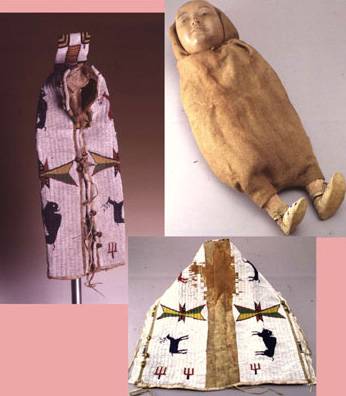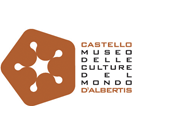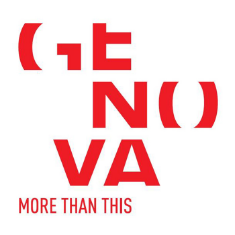
Click here to view image
vertical suspension cradle
Collezione Missioni Cattoliche Americane 1893
XIX - 1851
C.A.469/2
Sud Dakota (U.S.A.)
Cradle: tanned cervid leather, glass counties (opaque stitch), fabric, dry grass; Doll: decorticated, polished, carved and painted wood, jute, tanned leather, glass counties (point "lazy"), straw, iron
Ludica, predisposizione alla vita adulta. Porta-bebè. La madre vi poneva il neonato dopo aver imbottito il fondo di muschio, sterco di bisonte o pelo di coniglio, che avevano funzione assorbente. La culla veniva appoggiata o appesa per permettere alla madre di lavorare, oppure trasportata sulla schiena e fissata tramite una fascia di pelle che cingeva trasversalmente il petto e le braccia. Dai tre ai cinque mesi fino al momento in cui il bambino/a non muoveva i primi passi.
Indiani d'America: Fiori e vita dalle collezioni del museo etnografico Castello D'Albertis - Genova, Museo d'arte orientale E. Chiossone, 1996<br>Mostra d'arte precolombiana e di etnologia americana - Genova, Castello D'Albertis, 1972-1977
Deer skin bag lined with patterned fabric on a cream background. Decorated externally (except bottom) with glass beads in white (background), blue, red, green, yellow and blue to form zoomorphic (elk and bison) and geometric figures. The flaps are bordered internally by a double band of cream-coloured lace. Nine metal rattles and three dangling strands of metal conterie are attached along the outer edge. On the flaps are two leather ties on each side. On the bottom, to the part on which the child's head rested, is sewn a rectangular leather decorated entirely on both sides with white (background), red, yellow and blue conteries forming geometric patterns and parallel lines The mother would place the infant in it after stuffing the bottom with moss, bison dung or rabbit fur, which had an absorbent function. The cradle was either propped or hung to allow the mother to work, or carried on her back and secured by means of a leather band that encircled the chest and arms crosswise. The decorative geometric patterns, “many points” and parallel lines symbolize pregnancy scenes for the Dakota people; the trident motif symbolizes rain and the central symbol the four directions.




